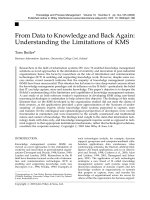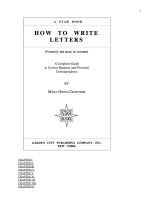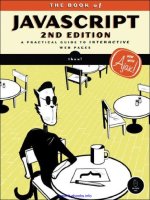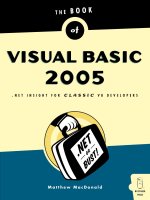The Book of Ruby pdf
Bạn đang xem bản rút gọn của tài liệu. Xem và tải ngay bản đầy đủ của tài liệu tại đây (7.81 MB, 404 trang )
Ruby is famous for being easy to learn, but most users
only scratch the surface of what it can do. While other
books focus on Ruby’s trendy features, The Book of
™
Ruby reveals the secret inner workings of one of the
world’s most popular programming languages, teaching
you to write clear, maintainable code.
You’ll start with the basics—types, data structures, and
control flows—and progress to advanced features like
blocks, mixins, metaclasses, and beyond. Rather than
bog you down with a lot of theory, The Book of Ruby
takes a hands-on approach and focuses on making you
productive from day one. As you follow along, you’ll
learn to:
• Leverage Ruby’s succinct and flexible syntax to
maximize your productivity
• Balance Ruby’s functional, imperative, and object-
oriented features
• Write self-modifying programs using dynamic
programming techniques
• Create new fibers and threads for lightweight
multitasking
MASTER
RUBY FROM THE
INSIDE OUT
MASTER
RUBY FROM THE
INSIDE OUT
• Catch and recover from execution errors with robust
exception handling
• Develop powerful web applications with the Ruby on
Rails framework
Each chapter includes a “Digging Deeper” section that
shows you how Ruby works under the hood, so you
won’t be caught off guard by its deceptively simple
scoping, multithreading features, or precedence rules.
Whether you’re new to programming or just new to
Ruby, The Book of Ruby is your guide to mastering rapid,
real-world software development with this unique and
elegant language.
ABOUT THE AUTHOR
Huw Collingbourne is the Director of Technology for
SapphireSteel Software, developer of the Ruby In Steel
IDE. With 30 years of programming experience, he has
written programming columns for numerous magazines,
presented features on computing for BBC Television,
and currently edits the online technical journal Bitwise
Magazine. He has previously released two free ebooks
on Ruby—The Little Book of Ruby and The Book of Ruby.
Covers Ruby 1.8 and 1.9
SHELVE IN :
COMPUTERS/PROGRAMMING
LANGUAGES/RUBY
$39.95 ($45.95 CDN)
www.nostarch.com
THE FINEST IN GEEK ENTERTAINMENT
™
“I LIE FLAT.”
This book uses a lay-flat binding that won’t snap shut.
FSC LOGO
HUW COLLINGBOURNE
THE BOOK OF
RUBY
THE BOOK OF
RUBY
A HANDS-ON GUIDE FOR THE ADVENTUROUS
™
™
THE BOOK OF RUBY
THE BOOK OF RUBY
COLLINGBOURNE
www.it-ebooks.info
www.it-ebooks.info
THE BOOK OF
™
RUBY
www.it-ebooks.info
www.it-ebooks.info
THE BOOK
OF
™
RUBY
A Hands-On Guide for
the Adventurous
by Huw Collingbourne
San Francisco
www.it-ebooks.info
THE BOOK OF RUBY. Copyright © 2011 by Huw Collingbourne
All rights reserved. No part of this work may be reproduced or transmitted in any form or by any means, electronic or
mechanical, including photocopying, recording, or by any information storage or retrieval system, without the prior
written permission of the copyright owner and the publisher.
Printed in Canada
15 14 13 12 11 1 2 3 4 5 6 7 8 9
ISBN-10: 1-59327-294-4
ISBN-13: 978-1-59327-294-4
Publisher: William Pollock
Production Editor: Serena Yang
Developmental Editor: Keith Fancher
Technical Reviewer: Pat Eyler
Copyeditor: Kim Wimpsett
Compositors: Serena Yang and Alison Law
Proofreader: Ward Webber
For information on book distributors or translations, please contact No Starch Press, Inc. directly:
No Starch Press, Inc.
38 Ringold Street, San Francisco, CA 94103
phone: 415.863.9900; fax: 415.863.9950; ; www.nostarch.com
Library of Congress Cataloging-in-Publication Data
Collingbourne, Huw.
The book of Ruby : a hands-on guide for the adventurous / Huw Collingbourne.
p. cm.
Includes index.
ISBN-13: 978-1-59327-294-4
ISBN-10: 1-59327-294-4
1. Ruby (Computer program language) 2. Object-oriented programming (Computer science) I. Title.
QA76.73.R83C65 2011
005.1'17 dc23
2011014782
No Starch Press and the No Starch Press logo are registered trademarks of No Starch Press, Inc. “The Book of” is
a trademark of No Starch Press, Inc. Other product and company names mentioned herein may be the trademarks
of their respective owners. Rather than use a trademark symbol with every occurrence of a trademarked name, we
are using the names only in an editorial fashion and to the benefit of the trademark owner, with no intention of
infringement of the trademark.
The information in this book is distributed on an “As Is” basis, without warranty. While every precaution has been
taken in the preparation of this work, neither the author nor No Starch Press, Inc. shall have any liability to any
person or entity with respect to any loss or damage caused or alleged to be caused directly or indirectly by the
information contained in it.
www.it-ebooks.info
BRIEF CONTENTS
Acknowledgments xv
Introduction xvii
Chapter 1: Strings, Numbers, Classes, and Objects 1
Chapter 2: Class Hierarchies, Attributes, and Class Variables 15
Chapter 3: Strings and Ranges 33
Chapter 4: Arrays and Hashes 47
Chapter 5: Loops and Iterators 67
Chapter 6: Conditional Statements 83
Chapter 7: Methods 97
Chapter 8: Passing Arguments and Returning Values 121
Chapter 9: Exception Handling 139
Chapter 10: Blocks, Procs, and Lambdas 155
Chapter 11: Symbols 181
Chapter 12: Modules and Mixins 191
Chapter 13: Files and IO 213
Chapter 14: YAML 227
Chapter 15: Marshal 239
www.it-ebooks.info
vi Brief Contents
Chapter 16: Regular Expressions 249
Chapter 17: Threads 263
Chapter 18: Debugging and Testing 283
Chapter 19: Ruby on Rails 299
Chapter 20: Dynamic Programming 325
Appendix A: Documenting Ruby with RDoc 345
Appendix B: Installing MySQL for Ruby on Rails 349
Appendix C: Further Reading 353
Appendix D: Ruby and Rails Development Software 357
Index 361
www.it-ebooks.info
CONTENTS IN DETAIL
ACKNOWLEDGMENTS xv
INTRODUCTION xvii
What Is Ruby? xviii
What Is Rails? xviii
Matters of Ruby Style xviii
How to Read This Book xix
Digging Deeper xix
Making Sense of the Text xix
Downloading Ruby xx
Getting the Source Code of the Sample Programs xxi
Running Ruby Programs xxi
The Ruby Library Documentation xxi
1
STRINGS, NUMBERS, CLASSES, AND OBJECTS 1
Getting and Putting Input 2
Strings and Embedded Evaluation 2
Numbers 3
Comments 4
Testing a Condition: if then 4
Local and Global Variables 5
Classes and Objects 6
Instance Variables 7
Retrieving Data from an Object 7
Messages, Methods, and Polymorphism 9
Constructors: new and initialize 10
Inspecting Objects 11
2
CLASS HIERARCHIES, ATTRIBUTES, AND
CLASS VARIABLES 15
Superclasses and Subclasses 17
Passing Arguments to the Superclass 18
Accessor Methods 19
Attribute Readers and Writers 20
Calling Methods of a Superclass 23
Class Variables 23
Digging Deeper 25
Superclasses 25
The Root of All Classes 29
Constants Inside Classes 30
Partial Classes 30
www.it-ebooks.info
viii Contents in Detail
3
STRINGS AND RANGES 33
User-Defined String Delimiters 35
Backquotes 36
String Handling 36
Concatenation 37
What About Commas? 38
String Assignment 38
Indexing into a String 39
Removing Newline Characters: chop and chomp 42
Format Strings 43
Ranges 43
Ranges of Strings 44
Iterating with a Range 44
Digging Deeper 45
Heredocs 45
String Literals 46
4
ARRAYS AND HASHES 47
Arrays 47
Creating Arrays 48
Multidimensional Arrays 50
Iterating over Arrays 51
Indexing into Arrays 52
Copying Arrays 53
Testing Arrays for Equality 53
Sorting Arrays 54
Comparing Values 55
Array Methods 57
Hashes 58
Creating Hashes 58
Indexing into a Hash 60
Copying a Hash 60
Hash Order 60
Sorting a Hash 61
Hash Methods 62
Digging Deeper 63
Treating Hashes as Arrays 63
Appending vs. Concatenating 63
Vectors and Matrices 64
Sets 65
5
LOOPS AND ITERATORS 67
for Loops 67
Blocks and Block Parameters 70
Iterating upto and downto 70
www.it-ebooks.info
Contents in Detail ix
Multiple Iterator Arguments 71
while Loops 72
while Modifiers 72
Ensuring a while Loop Executes at Least Once 73
until Loops 74
loop 75
Digging Deeper 76
The Enumerable Module 76
Custom Comparisons 77
each and yield 81
6
CONDITIONAL STATEMENTS 83
if then else 84
and, or, and not 85
Negation 86
if elsif 86
unless 88
if and unless Modifiers 88
Case Statements 89
The === Method 92
Alternative Case Syntax 92
Digging Deeper 93
Boolean Operators 93
Eccentricities of Boolean Operators 94
catch and throw 94
7
METHODS 97
Class Methods 97
What Are Class Methods For? 98
Class Variables 99
Ruby Constructors: new or initialize? 104
Singleton Methods 105
Singleton Classes 108
Overriding Methods 110
Public, Protected, and Private Methods 111
Digging Deeper 114
Protected and Private Methods in Descendant Classes 114
Invading the Privacy of Private Methods 116
Singleton Class Methods 116
Nested Methods 118
Method Names 119
8
PASSING ARGUMENTS AND RETURNING VALUES 121
Summarizing Instance, Class, and Singleton, Methods 121
Returning Values 123
www.it-ebooks.info
x Contents in Detail
Returning Multiple Values 124
Default and Multiple Arguments 124
Assignment and Parameter Passing 125
Integers Are Special 127
The One-Way-In, One-Way-Out Principle 128
Modifying Receivers and Yielding New Objects 130
Potential Side Effects of Reliance on Argument Values 131
Parallel Assignment 133
Digging Deeper 134
By Reference or By Value? 134
Are Assignments Copies or References? 135
Tests for Equality: == or equal? 136
When Are Two Objects Identical? 136
Parentheses Avoid Ambiguity 137
9
EXCEPTION HANDLING 139
rescue: Execute Code When Error Occurs 140
ensure: Execute Code Whether or Not an Error Occurs 144
else: Execute Code When No Error Occurs 145
Error Numbers 146
retry: Attempt to Execute Code Again After an Error 148
raise: Reactivate a Handled Error 149
Digging Deeper 152
Omitting begin and end 152
catch throw 152
10
BLOCKS, PROCS, AND LAMBDAS 155
What Is a Block? 156
Line Breaks Are Significant 156
Nameless Functions 157
Look Familiar? 158
Blocks and Arrays 159
Procs and Lambdas 161
Block or Hash? 161
Creating Objects from Blocks 162
What Is a Closure? 163
yield 164
Blocks Within Blocks 165
Passing Named Proc Arguments 165
Precedence Rules 170
Blocks as Iterators 172
Digging Deeper 175
Returning Blocks from Methods 175
Blocks and Instance Variables 176
Blocks and Local Variables 177
www.it-ebooks.info
Contents in Detail xi
11
SYMBOLS 181
Symbols and Strings 182
Symbols and Variables 186
Why Use Symbols? 188
Digging Deeper 190
What Is a Symbol? 190
12
MODULES AND MIXINS 191
A Module Is Like a Class . . . 192
Module Methods 192
Modules as Namespaces 193
Included Modules, or “Mixins” 194
Name Conflicts 198
Alias Methods 199
Mix In with Care! 200
Including Modules from Files 201
Digging Deeper 205
Modules and Classes 205
Predefined Modules 205
Scope Resolution 208
Module Functions 209
Extending Objects 210
Freezing Objects 211
13
FILES AND IO 213
Opening and Closing Files 214
Characters and Compatibility 216
Files and Directories 217
Copying Files 217
Directory Inquiries 219
A Discursion into Recursion 219
Sorting by Size 222
Digging Deeper 224
Recursion Made Simple 224
14
YAML 227
Converting to YAML 228
Nested Sequences 231
Saving YAML Data 231
Omitting Variables on Saving 232
Multiple Documents, One File 233
A YAML Database 234
www.it-ebooks.info
xii Contents in Detail
Adventures in YAML 236
Digging Deeper 237
A Brief Guide to YAML 237
15
MARSHAL 239
Saving and Loading Data 239
Omitting Variables on Saving 240
Saving Singletons 242
YAML and Singletons 242
Marshal and Singletons 243
Digging Deeper 246
Marshal Version Numbers 246
16
REGULAR EXPRESSIONS 249
Making Matches 250
Match Groups 253
MatchData 254
Prematch and Postmatch 255
Greedy Matching 256
String Methods 256
File Operations 258
Digging Deeper 260
Regular Expression Elements 260
Regular Expression Examples 260
Symbols and Regular Expressions 261
17
THREADS 263
Creating Threads 264
Running Threads 264
Going Native 265
The Main Thread 266
Thread Status 266
Ensuring That a Thread Executes 268
Thread Priorities 269
The Main Thread Priority 271
Mutexes 272
Fibers 275
Digging Deeper 278
Passing Execution to Other Threads 278
18
DEBUGGING AND TESTING 283
IRB: Interactive Ruby 283
Debugging 286
www.it-ebooks.info
Contents in Detail xiii
Unit Testing 292
Digging Deeper 295
Assertions Available When Unit Testing 295
Line Breaks Are Significant 296
Graphical Debuggers 297
19
RUBY ON RAILS 299
Installing Rails 300
Do It Yourself . . . 300
Or Use an “All-in-One” Installer 301
Model-View-Controller 301
A First Ruby on Rails Application 302
Create a Rails Application 302
Create a Controller 305
Anatomy of a Simple Rails Application 307
The Generate Controller Script Summarized 309
Create a View 310
Rails Tags 313
Let’s Make a Blog! 316
Create the Database 316
Creating a MySQL Database 317
Scaffolding 317
Migration 318
Partials 318
Test It! 320
Digging Deeper 322
MVC 322
The Rails Folders 323
Other Ruby Frameworks 324
20
DYNAMIC PROGRAMMING 325
Self-Modifying Programs 326
eval 327
Special Types of eval 329
Adding Variables and Methods 331
Creating Classes at Runtime 333
Bindings 334
send 336
Removing Methods 337
Handling Missing Methods 338
Writing Programs at Runtime 340
Exploring Further 341
Digging Deeper 342
Freezing Objects 342
A
DOCUMENTING RUBY WITH RDOC 345
www.it-ebooks.info
xiv Contents in Detail
B
INSTALLING MYSQL FOR RUBY ON RAILS 349
Downloading MySQL 350
Installing MySQL 350
Configuring MySQL 351
Can’t Find the Database? 351
C
FURTHER READING 353
Books 353
Ebooks 355
Websites 355
D
RUBY AND RAILS DEVELOPMENT SOFTWARE 357
IDEs and Editors 357
Web Servers 358
Databases 358
Ruby Implementations 359
INDEX 361
www.it-ebooks.info
ACKNOWLEDGMENTS
I’d like to express my appreciation of all the hard work
that’s gone into the preparation of this book by the
people at No Starch Press, especially Keith Fancher,
Serena Yang, and Bill Pollock. Thanks also to the copy-
editor, Kim Wimpsett, and to the technical reviewer, Pat
Eyler. For keeping me on the right side of sanity, I owe
a debt of gratitude to my two dogs, Beryl and Seven, and
to their beautiful mother, Bethan, who, to my enor-
mous sadness, died while I was writing this book.
www.it-ebooks.info
www.it-ebooks.info
INTRODUCTION
As you are now reading a book on Ruby,
I think it is safe to assume you don’t need
me to persuade you of the merits of the Ruby
language. Instead, I’ll take the somewhat unconven-
tional step of starting with a warning: Many people are
attracted to Ruby by its simple syntax and its ease of
use. They are wrong. Ruby’s syntax may look simple at
first sight, but the more you get to know the language, the more you will real-
ize that it is, on the contrary, extremely complex. The plain fact of the matter
is that Ruby has a number of pitfalls just waiting for unwary programmers to
drop into.
In this book, it is my aim to guide you safely over the pitfalls and lead you
through the choppy waters of Ruby’s syntax and class libraries. In the pro-
cess, I’ll be exploring both the smooth, well-paved highways and the gnarlier,
bumpy little byways of Ruby. By the end of the journey, you should be able to
use Ruby safely and effectively without getting caught by unexpected hazards
along the way.
www.it-ebooks.info
xviii Introduction
The Book of Ruby describes versions 1.8.x and 1.9.x of the Ruby language.
In most respects, Ruby 1.8 and 1.9 are very similar, and most programs writ-
ten for one version will run unmodified in the other. There are important
exceptions to this rule, however, and these are noted in the text. Ruby 1.9
may be regarded as a stepping stone toward Ruby 2.0. At the time of writing,
a release date for Ruby 2.0 has not been announced. Even so, on the basis of
currently available information, I anticipate that most (or all) of the informa-
tion on Ruby 1.9 in this book should also apply to Ruby 2.0.
What Is Ruby?
Ruby is a cross-platform interpreted language that has many features in com-
mon with other “scripting” languages such as Perl and Python. It has an eas-
ily readable type of syntax that looks somewhat Pascal-like at first sight. It is
thoroughly object-oriented and has a good deal in common with the great-
granddaddy of “pure” object-oriented languages, Smalltalk. It has been said
that the languages that most influenced the development of Ruby were Perl,
Smalltalk, Eiffel, Ada, and Lisp. The Ruby language was created by Yukihiro
Matsumoto (commonly known as Matz), and it was first released in 1995.
What Is Rails?
Over the past few years, much of the excitement surrounding Ruby can be
attributed to a web development framework called Rails—popularly known
as Ruby on Rails. Rails is an impressive framework, but it is not the be-all, end-
all of Ruby. Indeed, if you were to leap right into Rails development without
first mastering Ruby, you might find that you end up creating applications
that you don’t even understand. (This is all too common among Ruby on
Rails novices.) Understanding Ruby is a necessary prerequisite for under-
standing Rails. You’ll look at Rails in Chapter 19.
Matters of Ruby Style
Some Ruby programmers have very fixed—or even obsessive—views on what
constitutes a “Ruby style” of programming. Some, for example, are passionately
wedded to the idea that
method_names_use_underscores while variableNamesDoNot.
The style of naming in which separate words are indicated by capital letters
likeThis is called camel case—and that is the last time it will be mentioned in
this book.
I have never understood why people get so worked up about naming
conventions. You like underscores, I can’t stand them; you say po_ta_toes, I
say poTaToes. As far as I am concerned, the way in which you choose to write
the names of identifiers in Ruby is of no interest to anyone but you or your
programming colleagues.
That is not to say that I have no opinions on programming style. On the
contrary, I have very strong opinions. In my view, good programming style
has nothing to do with naming conventions and everything to do with good
www.it-ebooks.info
Introduction xix
code structure and clarity. Language elements such as parentheses, for
instance, are important. Parentheses clarify code and avoid ambiguity that,
in a highly dynamic language such as Ruby, can mean the difference between
a program that works as you expect and one that is full of surprises (also
known as bugs). For more on this, refer to the index entries on “ambiguity”
and “parentheses.”
In more than two decades of programming, one thing I have learned
through bitter experience is that the most important characteristics of well-
written code are clarity and lack of ambiguity. Code that is easy to understand
and easy to debug is also likely to be easier to maintain. If adopting certain
naming conventions helps you achieve that goal, that’s fine. If not, that’s fine
too. The Book of Ruby does not preach on matters of style.
How to Read This Book
The book is divided into bite-sized chunks. Each chapter introduces a theme
that is subdivided into subtopics. Each programming topic is accompanied
by one or more small, self-contained, ready-to-run Ruby programs.
If you want to follow a well-structured “course,” read each chapter in
sequence. If you prefer a more hands-on approach, you can run the pro-
grams first and refer to the text when you need an explanation. If you already
have some experience with Ruby, feel free to cherry-pick topics in any order
you find useful. There are no monolithic applications in this book, so you
don’t have to worry you might lose the plot if you read the chapters out of
order!
Digging Deeper
Every chapter, apart from the first one, includes a section called “Digging
Deeper.” This is where you will explore specific aspects of Ruby (including a
few of those gnarly byways I mentioned a moment ago) in greater depth. In
many cases, you could skip the “Digging Deeper” sections and still learn all
the Ruby you will ever need. On the other hand, it is in these sections that you
will often get closest to the inner workings of Ruby, so if you skip them, you
are going to miss out on some pretty interesting stuff.
Making Sense of the Text
In The Book of Ruby, Ruby source code is written like this:
def saysomething
puts( "Hello" )
end
Often the code will be annotated with comments. Ruby comments are
any text following a hash mark (
#) on a single line. The comments are
ignored by the Ruby interpreter. When I want to draw attention to some
www.it-ebooks.info
xx Introduction
output that Ruby displays or to a value returned by a piece of code (even if
that value is not displayed), I indicate this with this type of comment:
# =>.
Occasionally, when I want to draw attention to some input that the user
should enter, I use this type of comment:
# <=. Here is an example to illus-
trate these commenting conventions:
puts("Enter a calculation:" ) # Prompt user this is a simple comment
exp = gets().chomp() # <= Enter 2*4 comment shows data to enter
puts( eval( exp )) # => 8 comment shows result of evaluation
When a piece of code returns or displays too much data to be shown in a
single-line comment, the output may be shown like this:
This is the data returned from method #1
This is the data returned from method #2
This is the data returned from method #3
helloname.rb When a sample program accompanies the code, the program name is
shown in the margin as it is here.
Explanatory notes that provide hints or extra information are shown
like this:
NOTE This is an explanatory note.
More in-depth explanation of points mentioned in the text may be
shown in a box like this:
Downloading Ruby
You can download the latest version of Ruby at />downloads/. Be sure to download the binaries (not merely the source code).
Windows users have the option of installing Ruby using the Ruby Installer,
available at There are also several alternative
implementations of Ruby, the most established of which is JRuby. You
can find information on where to download these implementations in
Appendix D.
FURTHER EXPLANATION
This is some additional information. You can skip it if you like—but if you do, you
may miss something interesting!
www.it-ebooks.info
Introduction xxi
Getting the Source Code of the Sample Programs
All the programs in every chapter in this book are available for download as a
.zip archive at />When you unzip the programs, you will find that they are grouped into a
set of directories—one for each chapter.
Running Ruby Programs
It is often useful to keep a command window open in the source directory
containing your Ruby program files. Assuming that the Ruby interpreter is
correctly pathed on your system, you will then be able to run programs by
entering
ruby programname. For example, this is the command you would enter
in order to run the helloworld.rb program:
ruby helloworld.rb
If you use a Ruby IDE, you may be able to load the Ruby programs into
the IDE and run them using the integrated tools of that IDE.
The Ruby Library Documentation
The Book of Ruby covers many of the classes and methods in the standard Ruby
library—but by no means all of them! At some stage, therefore, you will need
to refer to documentation on the full range of classes used by Ruby. Fortu-
nately, the Ruby class library contains embedded documentation that has been
extracted and compiled into an easily browsable reference, which is available
in several formats. For example, you can find the online documentation for
Ruby 1.9 at For Ruby 1.8, go to
/>Okay, that’s enough of the preamble—let’s get down to work.
www.it-ebooks.info
www.it-ebooks.info
STRINGS, NUMBERS, CLASSES,
AND OBJECTS
The first thing to know about Ruby is that
it’s easy to use. To prove this, let’s look at
the code of the traditional “Hello world”
program:
1helloworld.rb puts 'hello world'
That’s it in its entirety. The program contains one method, puts, and one
string, “hello world.” It doesn’t have any headers or class definitions, and it
doesn’t have any import sections or “main” functions. This really is as simple
as it gets. Load the code, 1helloworld.rb, and try it.
www.it-ebooks.info









